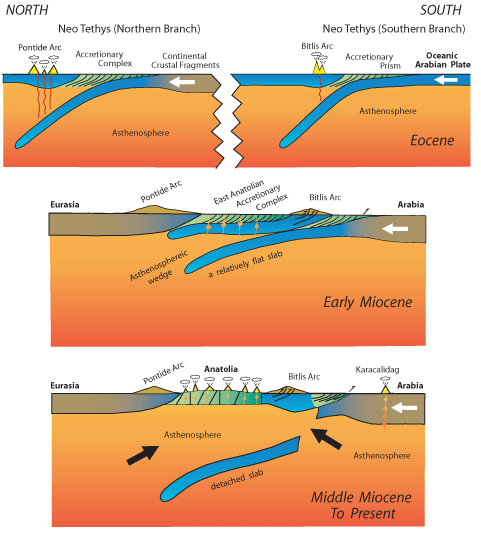
The Cenozoic geology and the present lithospheric and upper mantle structure of the Anatolian plateau in eastern Turkey and nearby regions are the result of the final collision and suturing of the continental Arabian plate to the Turkish terranes (i.e., micro-continents). This process of collision and suturing was strongly influenced by three active structures in the region: the Caucasus mountains, the Aegean subduction zone, and the Dead Sea fault system. Understanding these three major tectonic elements are important for the development of a robust model for the formation of the Anatolian plateau.
We show that the Anatolian plateau lithosphere in eastern Turkey has no lithospheric mantle, i.e., the crust floats on a partially molten asthenosphere. The average thickness of the crust in the region is approximately 45 km. The uppermost mantle beneath this crustal block strongly attenuates Sn waves and has one of the lowest Pn velocities on earth (about 7.6 km/s). The Anatolian plateau, with an average of 2 km elevation is dissected by numerous active, seismogenic faults (mostly strike-slip and some thrust type). Neogene and Quaternary volcanism with varying composition is widespread and covers more than half of the region.
We argue that the northward subduction of the northern and the southern branches of the Neo-Tethyan oceanic lithosphere since the Mesozoic has resulted in the development of arc and back-arc volcanism (i.e., the Pontide and Bitlis systems) and the development of the eastern Anatolian accretionary complex that covers a large area of eastern Turkey. The northward subduction of the southern Neo-Tethys considerably thinned and weakened the overriding Eurasian plate above the descending oceanic lithosphere of the Arabian plate. The final suturing of the continental Arabian plate with the Turkish terranes in the Miocene and the continued convergence of Arabia relative to Eurasia has resulted in the shortening of the accretionary complex both in the forearc and the back-arc regions and the development of a broad zone with numerous strike-slip faults. The mobilization of the Caucasus is also partially a consequence of this convergence. The documented major episode of widespread volcanism at about 11 Ma is probably related to the breakoff of the shallowly descending oceanic segment of the Arabian lithosphere beneath eastern Turkey. The continued convergence of Arabia relative to Eurasia has resulted in the development of the North Anatolian fault (NAF) and subsequently the East Anatolian fault (EAF) in the Pliocene. At about this time, the northern segment of the Dead Sea fault (DSF) also developed in Lebanon and northwest Syria and joined the EAF to form the Anatolian - Arabian - African triple junction in the Maras region of southern Turkey. The development of these fault systems (i.e., NAF, EAF, and DSF) provided the mechanism for the tectonic escape of the Anatolian crustal block towards the Aegean arc system.
Geological Society of America, P.O. Box 9140, Boulder, CO 80301-9140 USA (http://www.geosociety.org)
© 2006, Geological Society of America
Link to GSA listing of this publication
Figure 7. Schematic cross sections showing tectonic evolution of the Anatolian plateau in eastern Anatolia from the Eocene to the Present. The cross sections are constructed approximately along the 42ºE longitude line.
